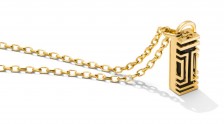Tory Burch Takes on Wearables
Shannon Fong, Associate Director of Industrial Design, takes a look at the new collaboration between Tory Burch and Fitbit.
I have to confess, like many other people I know, I gave up on my activity tracker. At first, I was really enthusiastic about my new band. I loved seeing my progress day to day and meeting my goals on the friendly app. As far as looks go, it had an attractive pattern and nice details.
As the weeks passed and the novelty wore off, little things started to bother me. I found that I didn’t like the feel of the rubber against my skin and on some days the sporty look of the band just didn’t go with what I wanted to wear. When getting ready in the morning, I felt like I had to choose between accessorizing with the jewelry I owned, and wearing my activity tracker. One day the activity tracker lost out and it never regained its place on my wrist – it just didn’t fit seamlessly into my life.
I don’t think I’m alone in feeling this way. Through our research with women, many have indicated a similar frustration with needing to change their lives to adapt to new technologies, as opposed to new technologies seamlessly fitting into their lives. Technology typically stands out – companies are used to highlighting the biggest screens, the coolest UI, or the highest quality audio. When it comes to wearing technology, however, many of the women we’ve talked to say that they loved the benefits – they just wanted the technology to disappear.
Wearables companies, thankfully, are attempting to combat this issue and better integrate into women’s lives. The Tory Burch and Fitbit collaboration is a great example of how more and more companies are making wearables more fashionable and jewelry-like by taking cues from the accessories women wear on a daily basis. This makes sense when you consider that most wearables are worn all day, and women spend the majority of that time in everyday clothes, not workout gear. Ringly fits squarely in this camp by offering women a ring that discreetly notifies them of calls and text messages via vibration or a small light.
Products like the Fitbit Flex or Misfit Shine offer flexibility in the way you wear your device. They have a variety of options, including bands, bracelets, clips and necklaces that suit a variety of situations. This allows women to choose something like jewelry for work and going out, but still use a band or clip when working out. Fitbit’s partnership with Tory Burch resulted in an attractive brass bracelet and pendant that disguises the technology and looks appropriate for a night out.
As wearables get more feature-rich, they’ll move away from the passive interaction of activity trackers to a more direct interaction seen in smart watches. The challenge will then be how to give women the appropriate information at the right time. Many women are concerned that wearing technology can cause them to look distracted and not engaged with the people around them. Future wearables will not only need to fit seamlessly into a woman’s life; there will have to be thoughtful considerations for how the technology affects the people that she cares about.
Photo courtesy of Fitbit.





